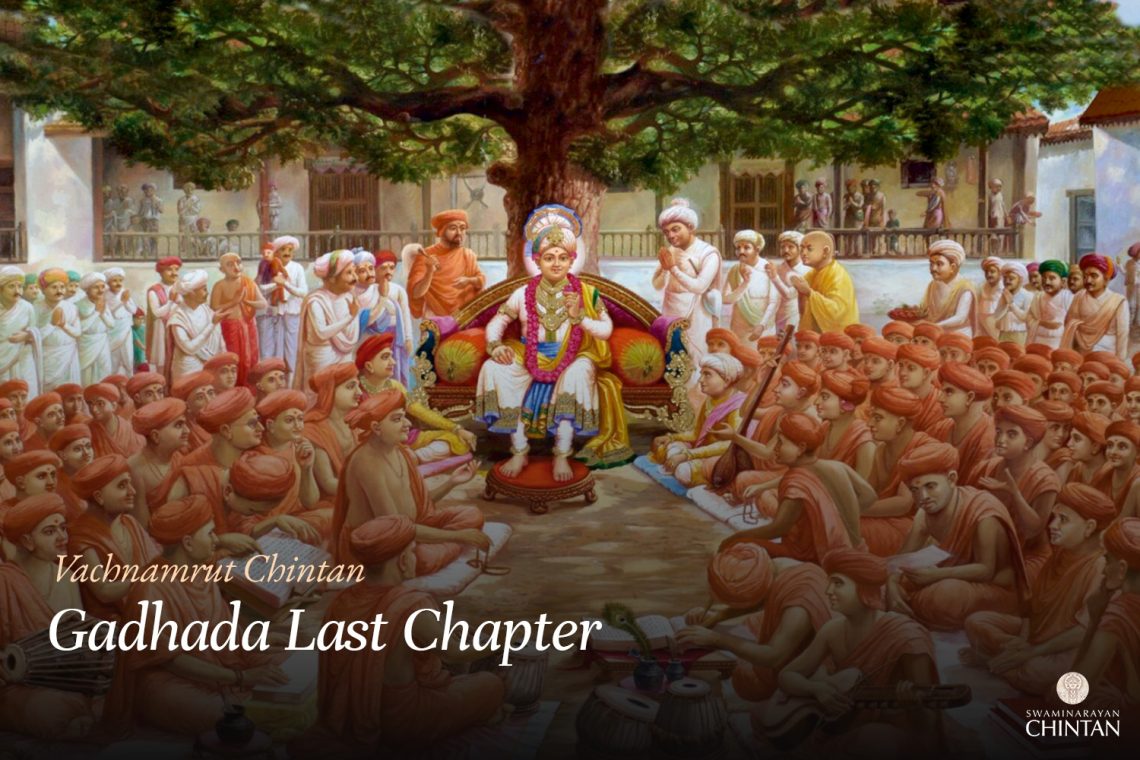Central Insights:
- Who can subdue desires?
Key Points:
- Those with manda vairagya (moderate non-attachment) should progress through grihasthashram (householder stage) before moving to vanaprastha (secluded life) and then to sannyas (renunciation).
- If someone establishes intense affection for an uttam sant (exalted saint) and directly takes sannyas, their renunciation can still succeed.
Explanation:
In this Vachanamrut, Maharaj asked Shukmuni a question. There are two satsangis (members of the holy fellowship), both aged 20 years. Both possess steadfast nishchay (conviction), het-bhakti (affectionate devotion), vairagya (non-attachment), and dharma (moral integrity). One of them, due to prarabdha (destiny), marries and lives with a wife, while the other remains unmarried as a sankhyayogi (renunciate). Though the latter had the desire to marry, he could not find a spouse. Neither of them initially had teevra vairagya (intense non-attachment), and both were inclined toward sensory indulgence. Maharaj’s question is: Whose desires will diminish—the householder’s or the renunciate’s?
The Ved states that those with teevra vairagya should renounce the world from the stage of brahmacharya (celibacy). Those with manda vairagya should follow the householder’s path to moderate their intense desires and then transition to vanaprastha and sannyas. Maharaj instructed Shukmuni to think carefully before responding. When Shukmuni could not provide a satisfactory answer, Maharaj offered His explanation.
This type of discussion also appears in Vachanamrut Gadhada First Chapter 14 and Vachanamrut Gadhada Middle Chapter 25. Here, both individuals lack teevra vairagya and possess manda vairagya. Their desires are intense. The central question is whether desires are subdued through indulgence (bhog) or renunciation (tyag). This requires contemplation. Desires are never calmed by indulgence. As the shastra states, हविषा कृष्ण वत्र्मैव भूयो एवाभिवर्धते — haviṣā kṛṣṇavartmaiva bhūyo evābhivardhate, like pouring ghee into fire, indulgence only fuels desires. On the other hand, scriptures suggest that only those with teevra vairagya should renounce sensory pleasures. Those with manda vairagya should not renounce indulgence entirely.
So, the question arises: Does indulgence in sensory pleasures reduce desires or amplify them?
Maharaj and the shastrakars (scriptural authorities) agree that those with manda vairagya should adopt the householder’s path, as it involves responsibilities alongside limited indulgence. Responsibilities precede enjoyment, and any pleasure attained is minimal and uncertain. Suffering and hardships, however, are inevitable. This reality naturally curtails desires. In tyagashram (renunciatory stage), such responsibility does not exist, and the unrestricted indulgence may exacerbate desires. Therefore, Maharaj emphasizes that only those with teevra vairagya should renounce.
Shukmuni raised a thoughtful question: “Maharaj, can’t a person with manda vairagya develop teevra vairagya through association with a great sant, learning about God’s glory, and contemplating it? Often, individuals who initially lack vairagya later develop it. How should this be understood?”
Maharaj responded: “It is rare for someone with manda vairagya to develop teevra vairagya independently. However, if such a person forms intense affection (het) for a great sant endowed with dharma, gnan (knowledge), vairagya, and bhakti, they will act solely according to the sant’s wishes, avoiding anything that displeases the sant. In such a case, even without vairagya, their renunciation succeeds. Their affection for the sant effectively substitutes for intense vairagya.”
Maharaj then illustrated this principle using an example from our satsang. Everyone loves Maharaj deeply. Saints, devotees, and even those with manda vairagya act vigilantly, emulating those with teevra vairagya. This conduct stems from their affection for Maharaj, regardless of their inherent level of vairagya or intensity of desires.
Maharaj concluded: “Those with manda vairagya should enter the grihasthashram, fulfill their challenging responsibilities, and adhere to dharma to subdue their desires. If a renunciate has manda vairagya, they must cultivate deep affection for a great sant. This affection can subdue even intense desires and lead to successful renunciation. Without such affection, their renunciation cannot succeed.”
Glossary
| Nishchay – Firm Faith in Manifested God Believing Manifested God (Bhagwan Swaminarayan) as “My Beloved God” (My Istadev) |
| Het-Bhakti – Affectionate devotion |
| Vairagya – Detachment From Everything Except God |
| Teevra Vairagya – Intense non- attachment |
| Manda Vairagya – Moderate non-attachment |
| Prarabdha – Destiny |
| Grihasthashram – Householder life A stage of life focused on fulfilling worldly and familial responsibilities while maintaining spiritual growth. |
| Vanaprastha – Secluded life The life stage of partial renunciation, transitioning from worldly responsibilities to spiritual focus. |
| Sannyas – Renunciation The life stage of complete renunciation, focusing entirely on spiritual practices and detachment. |
| Sankhyayogi – Renunciate A person who has renounced worldly life to focus on knowledge and meditation on Bhagwan. |
| Bhog – Indulgence |
| Tyag – Renunciation |
| Shastrakar – Scriptural authority Scholars or authors of sacred texts who provide spiritual guidance and principles. |
| Dharma – Righteous conduct |
| Intense Affection – Deep attachment to a great saint |
| Gyan – Knowledge |

